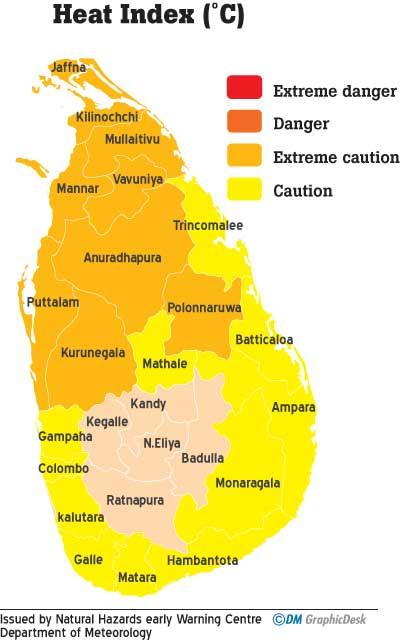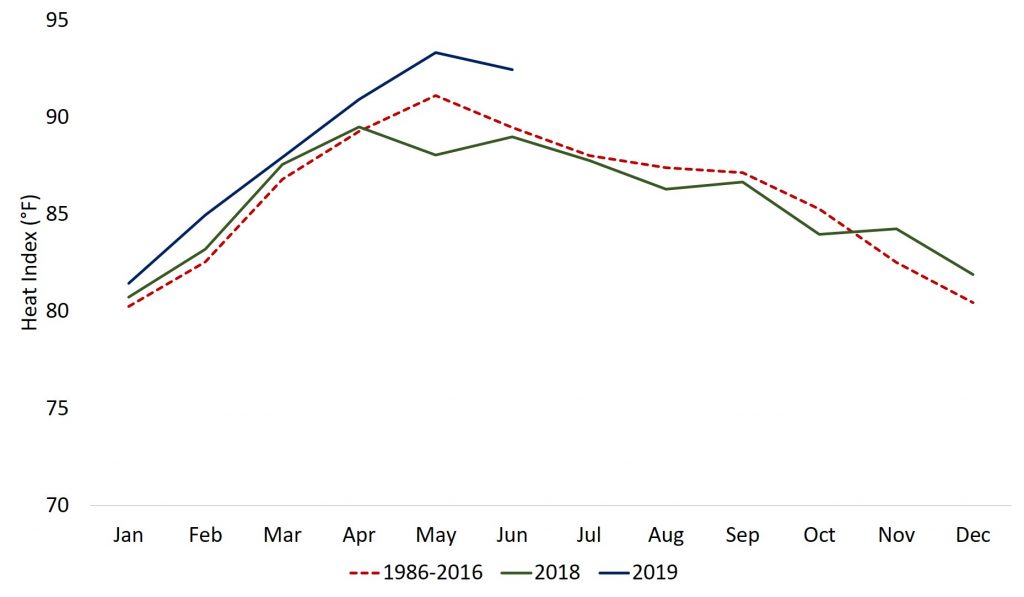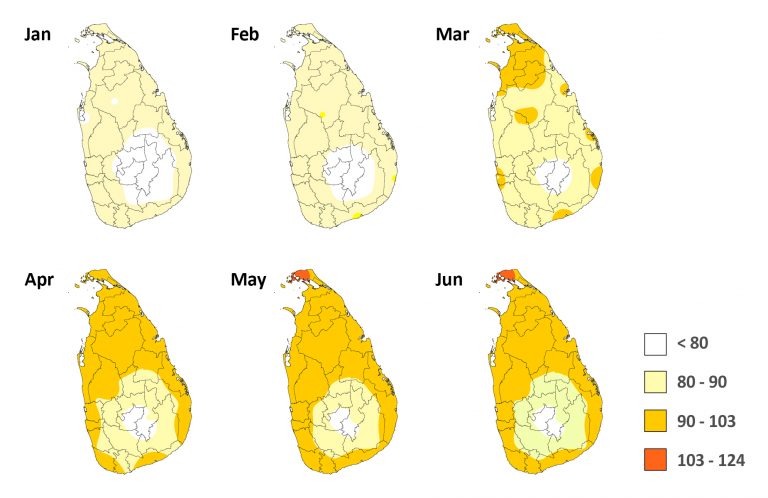Source:http://www.dailymirror.lk/opinion/People-told-to-brace-themselves-during-warm-weather/172-163917
By Sheain Fernandopulle
Sri Lanka’s weather is tropical and climatically the island is divided into two monsoonal seasons which bring rain to the west and south-west coasts from May to September; and the east coast and northern region between October and February. The rest of the year is sunny and dry. Temperatures are fairly constant year round, with coastal regions enjoying average temperatures of 25-30°C and the highlands 15-18°C on average.
However, the general public has been inconvenienced owing to the hot weather being experienced in some parts of the country to a considerable degree for the past one and half weeks.
The Department of Meteorology has issued several heat weather advisories warning the people in 14 districts to be extremely cautious of the hot weather.
Vulnerable areas
 According to the heat advisory issued by the Med Department, the 14 districts that are likely to be affected are Jaffna, Kilinochchi, Mannar, Mullaitivu, Vavuniya, Trincomalee, Anuradhapura, Puttalam, Polonnaruwa, Kurunegala, Monaragala, Batticaloa, Ampara and Hambantota.
According to the heat advisory issued by the Med Department, the 14 districts that are likely to be affected are Jaffna, Kilinochchi, Mannar, Mullaitivu, Vavuniya, Trincomalee, Anuradhapura, Puttalam, Polonnaruwa, Kurunegala, Monaragala, Batticaloa, Ampara and Hambantota.
The department warned that those living in these areas should avoid venturing outside too much during the next few days, particularly in the morning hours as heat strokes, cramps and heat exhaustion were some of the after effects that could occur if precautions were not taken.
Several areas including Matale, Gampaha, Colombo, Kalutara, Galle and Matara would also experience dry weather and residents were warned to take extra precautions when being out in the open in these areas as well.
The maximum temperature so far has been 35.4°C and was reported from the Puttalam district.
The department warned that those living in these areas should avoid venturing outside too much during the next few days
Heat Index Forecast
 The Meteorology Department said that the Heat Index Forecast is calculated by using relative humidity and maximum temperature and this is the condition that is felt on the body.
The Meteorology Department said that the Heat Index Forecast is calculated by using relative humidity and maximum temperature and this is the condition that is felt on the body.
This is not the forecast of maximum temperature. “lt is generated by the Department of Meteorology for the next day and is prepared by using global numerical weather prediction model data,” Met Department said.
The relative humidity of the air is the amount of water that is present in the air compared to the greatest amount it would be possible for the air to hold at that temperature.
The situation would last till May ends. Speaking to the Daily Mirror Deputy Director of the Meteorology Department and Director forecasting Anusha Warnasuriya said that the following four factors mainly caused for the prevalence of the hot weather.
- Calm of the wind
- Increase in humidity in low atmosphere that leads to increase sweating
- Loss of shade with clouds in day time leads to directly fall sunlight onto the ground
- The wind blows from the sea.
“This situation would last till the end of May and would fully decay on the verge of South-west Monsoon,” Warnasuriya said.
She added that people living in the Northern Province and coastal areas would feel the hot the most.
Meanwhile, an official of the Meteorology Department said that a temperature exceeding 40°C might also be experienced in the future.
He said that there have been several occasions in the past where a temperature exceeding 40°C had been reported.
The relative humidity of the air is the amount of water that is present in the air compared to the greatest amount it would be possible for the air to hold at that temperature. The situation would last till May ends
Tips to beat heat related illnesses
The Department of Meteorology with the assistance of the Ministry of Health, issued a recent bulletin on precautionary measures to be taken during the warm weather. Instructions were given to increase the intake of liquids while avoiding exposure to hot sun as much as possible
Let’s follow these instructions to avoid excessive heat
- Wear light colored, loose fitting, light weight clothes.
- Wear long sleeved clothes which cover the body adequately to prevent body getting from being exposed to the sun.
- Stay under a shade, whenever possible
- During outdoor activities in the day time, take following precautions.
I . Use an umbrella
II. Wear a wide brimmed hat
III.Wear standard sunglasses
IV. Apply sun screen (SPF-Sun Protecting Factor 30 or above) at least 30 minutes before you go outdoors. According to product instructions, you may reapply whenever necessary.
- If engaged in daily outdoor activities such as agriculture and construction related work, make sure you wear light colored, loose fitting clothing which covers your body adequately.
- Have a daily bath. Take a shower couple of times a day.
- Try to restrict outdoor activities as much as possible during day time. Try to plan these activities in early morning or during evening hours.
- When you stay outdoors, remember to stay in the shady areas whenever possible.
- Discourage school children from engaging in outdoor activities when the sun is shining brightly.
- Don’t leave children or your pets in the parked vehicle, especially in cars even with an opened window, since cars parked outside can easily heat up and may cause heat related illnesses.
- Keep a basin of water near the fan indoors which will help to reduce evaporation of water from your body.
- Let’s follow these instructions to stay hydrated
- Drink plenty of fluids more than your daily usual intake.
- Drink fluids frequently. Don’t wait until you feel thirsty.
- Each time you urinate, remember to rehydrate yourself by drinking water.
- Stay away from very sugary or alcoholic drinks, since these causes you to lose more water from body.
- Be alert on the following discomforts you may get due to heat
- Small red colored rash look like pimples on the skin (especially around the neck, chest. groin or elbow crease) – (Heat Rash)
- Warm, red colored painful skin (Sun Bum)
- Excessive sweating
- Muscle cramps or muscle pain
- Vomiting or nausea
- Excessive weakness or tiredness
- Headache
- Fainting attacks
The Health Promotion Bureau has requested the general public to seek medical advice immediately if they experience these discomforts mentioned above.
High risk groups requiring special attention
- Infants and young children
- People 65 years of age or older
- People who are overweight and obese
- People who are exert during work or exercise
- People who are physically ill (Especially who are with heart disease or high blood pressure)




 According to the heat advisory issued by the Med Department, the 14 districts that are likely to be affected are Jaffna, Kilinochchi, Mannar, Mullaitivu, Vavuniya, Trincomalee, Anuradhapura, Puttalam, Polonnaruwa, Kurunegala, Monaragala, Batticaloa, Ampara and Hambantota.
According to the heat advisory issued by the Med Department, the 14 districts that are likely to be affected are Jaffna, Kilinochchi, Mannar, Mullaitivu, Vavuniya, Trincomalee, Anuradhapura, Puttalam, Polonnaruwa, Kurunegala, Monaragala, Batticaloa, Ampara and Hambantota. The Meteorology Department said that the Heat Index Forecast is calculated by using relative humidity and maximum temperature and this is the condition that is felt on the body.
The Meteorology Department said that the Heat Index Forecast is calculated by using relative humidity and maximum temperature and this is the condition that is felt on the body.